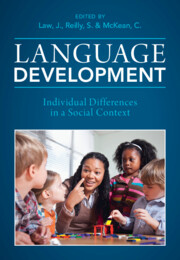Book contents
- Language Development
- Language Development
- Copyright page
- Contents
- Figures
- Tables
- Contributors
- A Tribute to Our Friend, Colleague and Fellow Editor, Professor James Law
- Introduction
- Part One Factors Influencing Language Development
- 3 Genetic Studies of Language Disorders
- 4 Hearing and Language
- 5 Co-occurrence between Language Disorders and Common Conditions in Childhood
- 6 Language and Cognition
- 7 Growing Up in Multilingual Communities
- 8 Parent–Child Interaction and Its Impact on Language Development
- 9 Cognitive Competencies and Signals of Risk
- 10 Creating Equitable Opportunities for Language and Literacy Development in Childhood and Adolescence
- Part Two Continuity and Change
- Part Three Impact, Intervention and Equity
- Index
- References
6 - Language and Cognition
from Part One - Factors Influencing Language Development
Published online by Cambridge University Press: 11 August 2022
- Language Development
- Language Development
- Copyright page
- Contents
- Figures
- Tables
- Contributors
- A Tribute to Our Friend, Colleague and Fellow Editor, Professor James Law
- Introduction
- Part One Factors Influencing Language Development
- 3 Genetic Studies of Language Disorders
- 4 Hearing and Language
- 5 Co-occurrence between Language Disorders and Common Conditions in Childhood
- 6 Language and Cognition
- 7 Growing Up in Multilingual Communities
- 8 Parent–Child Interaction and Its Impact on Language Development
- 9 Cognitive Competencies and Signals of Risk
- 10 Creating Equitable Opportunities for Language and Literacy Development in Childhood and Adolescence
- Part Two Continuity and Change
- Part Three Impact, Intervention and Equity
- Index
- References
Summary
The development of language and cognition is key to human development. Language is an important means to communicate and code information; it is relevant to knowledge and concept acquisition, to memory performance and development, to problem solving, learning and self-regulation. At the same time, language development draws on cognitive and socio-cognitive abilities. Analysing the developmental interrelations between language and cognition is relevant for a better understanding of developmental trajectories in typical development and developmental disorders as well as for the promotion of child development. Contrary to some overarching theories, it is widely documented that developmental profiles can be quite heterogeneous: the developmental tasks the child is facing in the various domains of development, the trajectories, and phenomena are specific to the respective developmental domain or even subdomain. Yet there are significant and dynamic interrelationships between the acquisition of language structures, meanings, and use and various cognitive abilities and their development. This chapter introduces the reader to a variety of dynamic interrelationships between the acquisition of language and various facets of cognitive and sociocognitive development (e.g., information processing, learning and memory; conceptual development; development of metacognition, theory of mind and self-regulation).
Keywords
- Type
- Chapter
- Information
- Language DevelopmentIndividual Differences in a Social Context, pp. 122 - 143Publisher: Cambridge University PressPrint publication year: 2022
References
- 5
- Cited by

